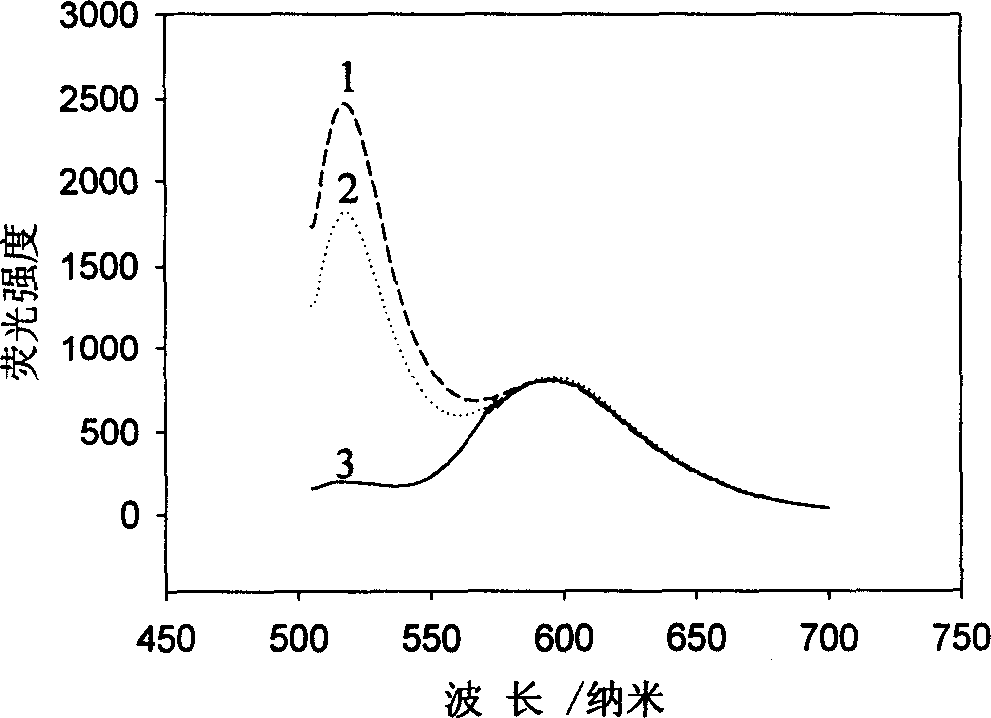Method for producing internal reference nano PH sensor and using for in-cell PH non-trauma monitoring
A pH sensor and internal reference technology, applied in the field of nanomaterials, can solve the problems of complex preparation process of PEBBLES sensor, sensitive dye measurement error, interference pH measurement, etc., and achieve biocompatibility, improved reliability, and stable physical and chemical properties. Effect
- Summary
- Abstract
- Description
- Claims
- Application Information
AI Technical Summary
Problems solved by technology
Method used
Image
Examples
Embodiment 1
[0042] Example 1, preparing a silicon-shell fluorescent nanometer pH sensor with an internal reference:
[0043] The first step is to configure the solutions of sensitive dye and reference dye: equimolar 0.1mol / L saturated FITC solution of fluorescein isothiocyanate and aminosilylating reagent γ-aminopropyltriethoxysilane (APTES) Mix and react overnight at room temperature in the dark, then mix the obtained product FITC-APTES (80 μL) with 0.1 mol / L biruthenium pyridine solution (10 μL) and set aside.
[0044] In the second step, cyclohexane (7.5mL), surfactant Triton X-100 (TritonX-100, 1.8mL) and co-surfactant n-hexanol (1.8mL) were mixed evenly, and 310 μL of water was added as the dispersed phase , stir until the solution is a clear and translucent water-in-oil microemulsion, add the sensitive dye and reference dye mixture prepared in the first step, stir evenly, add 200 μL of silylating reagent orthoethyl silicate (TEOS) and 200 μL of catalytic ammonia water, The reaction l...
Embodiment 2
[0045] Example 2, a silicon-shell fluorescent nanopH sensor with an internal reference is used for non-invasive monitoring of pH in macrophages
[0046] The first step is to draw the standard curve of the nanosensor’s response to pH. The specific process is: add 5 μL of nanoparticles to 200 μL of buffer solution with different pH, react for 5 minutes, and drop the solution onto the laser confocal microscope stage On the glass slide, record the respective relative fluorescence intensity of sensitive dye fluorescein isothiocyanate FITC and reference dye biruthenium pyridine Rubpy in the nanoparticle, calculate the fluorescence ratio of the two (I FITC / I Rubpy ), and the experiment was repeated three times. Taking pH as the abscissa, I FITC / I Rubpy Draw the response curve of nanoparticles to pH for the ordinate, such as image 3 , the linear range of the nanosensor to pH response is 4-7.5, since the pH change in the cytoplasm and organelles is just in the range of pH5-7 und...
Embodiment 3
[0050] Example 3, a silicon-shell fluorescent nanopH sensor with an internal reference is used for non-invasive monitoring of pH in liver cancer cells
[0051] In the first step, the liver cancer cells were pre-cultured to 70% coverage 24 hours before observing the intracellular pH, and the culture medium was discarded. Dilute and disperse the pre-sonicated 8μL nanosensor suspension with 1mL serum-free medium, then add it to the culture dish with liver cancer cells, and incubate at 37°C for 4 hours. Since the size of the nanosensor is about 40nm, liver cancer The cells can endocytose the sensor into the cell, realizing the non-invasive introduction of the nanometer pH sensor into the liver cancer cells. Wash the cells three times with cold phosphate buffered saline (PBS, pH7.4) before observation, remove excess nanosensors in the medium that have not been phagocytosed by cells and nanosensors non-specifically adsorbed on the surface of liver cancer cells, and then add 1 mL pH6...
PUM
| Property | Measurement | Unit |
|---|---|---|
| size | aaaaa | aaaaa |
| size | aaaaa | aaaaa |
Abstract
Description
Claims
Application Information
 Login to View More
Login to View More - R&D
- Intellectual Property
- Life Sciences
- Materials
- Tech Scout
- Unparalleled Data Quality
- Higher Quality Content
- 60% Fewer Hallucinations
Browse by: Latest US Patents, China's latest patents, Technical Efficacy Thesaurus, Application Domain, Technology Topic, Popular Technical Reports.
© 2025 PatSnap. All rights reserved.Legal|Privacy policy|Modern Slavery Act Transparency Statement|Sitemap|About US| Contact US: help@patsnap.com



